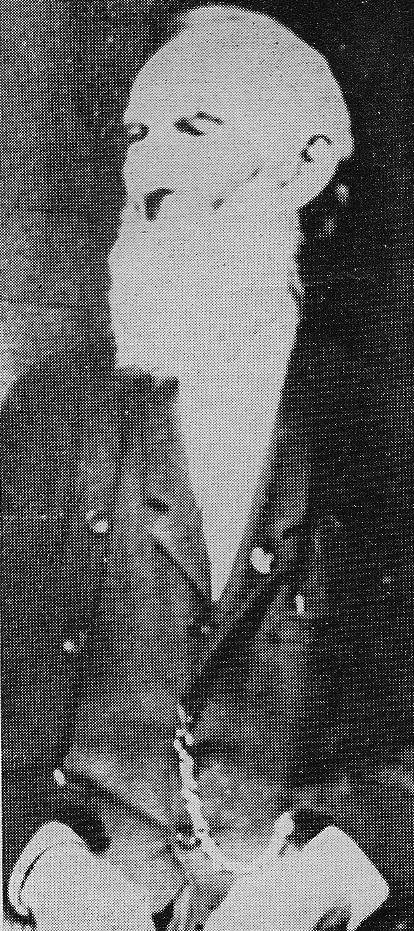 A RESTORED MUZZLE LOADING RIFLE MADE BY SAM STULL
A RESTORED MUZZLE LOADING RIFLE MADE BY SAM STULL An earlier version of this article appeared in the February 2018 issue of Muzzle Blasts, the
official journal of the National Muzzle Loading Rifle Association
 A RESTORED MUZZLE LOADING RIFLE MADE BY SAM STULL
A RESTORED MUZZLE LOADING RIFLE MADE BY SAM STULL Sam Stull (1808-1907; at left) was a well-known Ohio gunsmith. Born in Coshocton County, he moved to and spent most of his life in the tiny hamlet of Millwood not far away in neighboring Knox County. Throughout his long life he made hundreds of rifles that were prized by their owners for fine workmanship and accuracy. Stull’s guns are some of the best examples of the small-caliber rifles made for small game and target shooting after Ohio ceased to be the “frontier” of the westward expansion. Many of his descendants live in central Ohio to this day. I’ve spoken with one of them, who told me that “several” Stull rifles are still extant: now and then one comes up for sale: a Stull rifle was sold in a James Cowan auction in 2005, but that's the only example I've been able to find. They are thin on the ground. It's impossible to date the gun exactly, but one authority has stated that Stull’s “later” rifles were marked with stamped block letters “S. STULL /OHIO” in two lines, as this one is. We believe it to have been made sometime in the mid 1860’s.
The .32 caliber percussion rifle that’s the subject of this article once belonged to the Outdoorsman's late father-in-law, Leo Wolfe (1916-1999). Leo lived all his life in the village of Gambier, Ohio, about 12 miles from Millwood. According to his account the rifle had belonged to his father, Jacob Wolfe (1850-1943), another lifelong Knox County resident; Leo and his brothers hunted small game with it as boys, into the early 1940’s.
Stull was a secretive man by all accounts, and wasn’t prone to let people into his shop. Regrettably his records seem to have been destroyed or discarded over the years, and I’ve never had any success in tracking them down if they do exist. Readers of this article who may know of more surviving examples of Stull’s work, and/or more details about his life, especially what may have been the fate of his shop records, are requested to please contact the author with any information.
Most of Stull's rifles were fairly plain working guns; considering the level of ornamentation on this one, it may have been ordered as a present for some significant event in Jacob Wolfe’s life. Jacob would have been in his teens in the 1860’s; since he didn’t marry until late in life (1900) if this gun was indeed a present, it may have been a “coming-of-age” or perhaps a baptismal gift. But in the absence of Stull’s records and order book, we are only speculating.
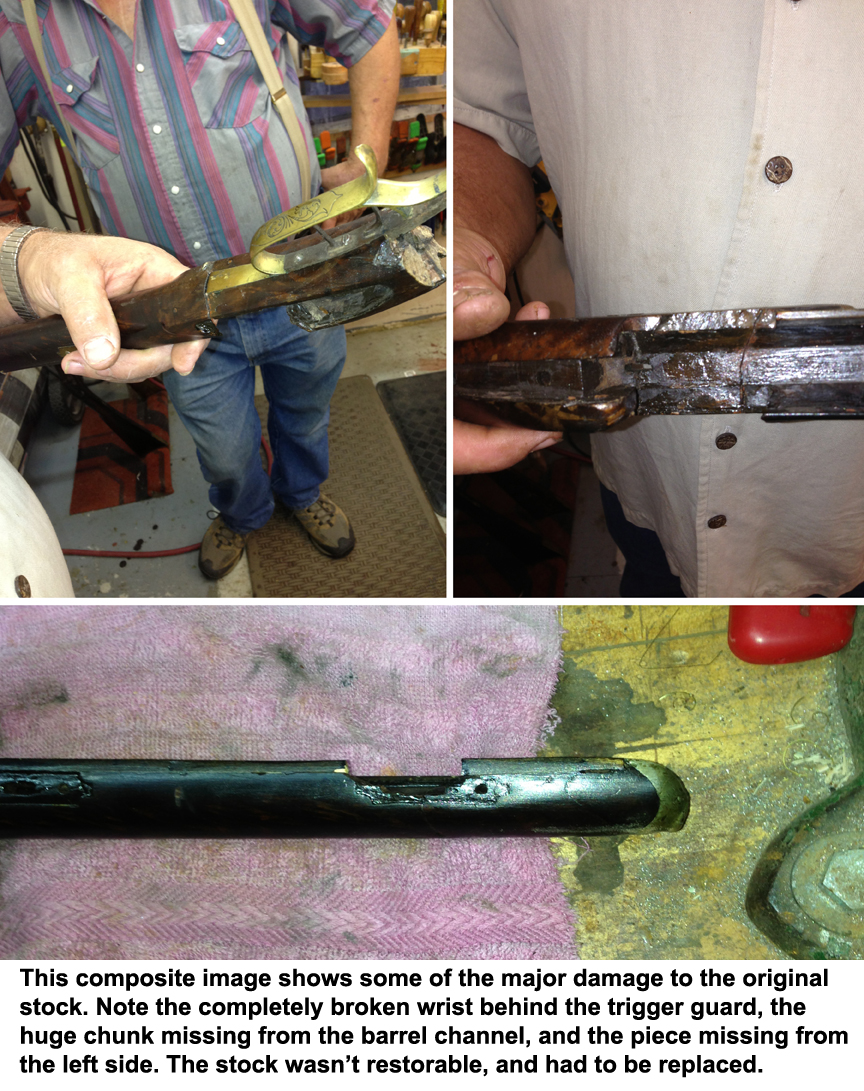
When Leo died the rifle came into my possession. It was in terrible condition: although the lock and the barrel were in decent shape considering their age, the stock was literally held together with electrical tape. Although Stull seems often to have used maple for his stocks this one was done in fine burl walnut. Years of hard usage and drying had caused it to break across the wrist (it had been crudely “repaired” with iron straps and miscellaneous screws); the fore-end had been completely broken across and large chunks of the barrel channel were missing. The breech plug tang was broken as well. Luckily the brass ornamental inlays and wedge slot escutcheons were intact but the stock was fit only for firewood.

It seemed a shame to let a fine artifact from a “name” maker, especially one with a well-documented geographic and family provenance, remain in such poor shape. I contacted Mike (who builds muzzle-loaders as a hobby) to ask if he knew someone who could restore it. Mike was in touch with Sam Thompson from McLean, Virginia and and Larry Gardner from Burtonsville, Maryland; Sam agreed to do the job, warning that it would take a year to complete.
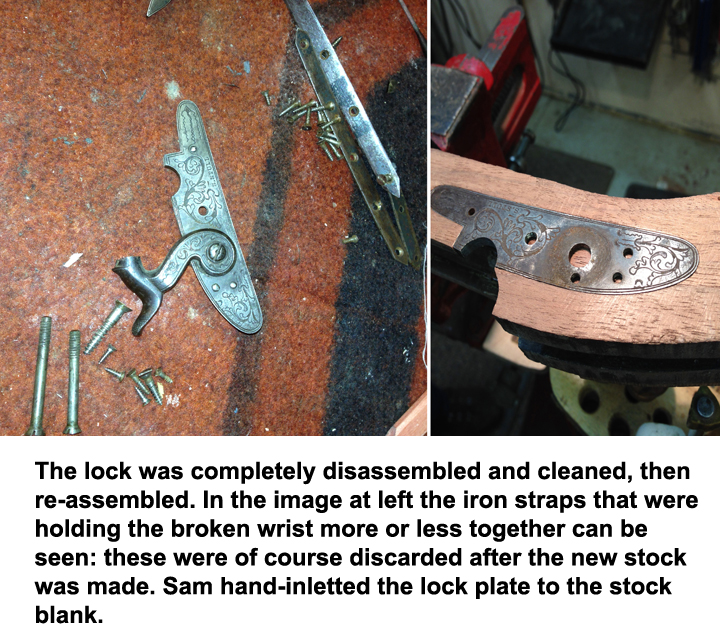
Mike very generously contributed a beautiful walnut stock blank to the project. After discussions among all of us a decision was taken to create the replacement stock with the exact contours of the original. Hence the decrepit old stock was roughly re-assembled to serve as the model for the new one. At the same time the metal parts were to be overhauled and repaired as needed.
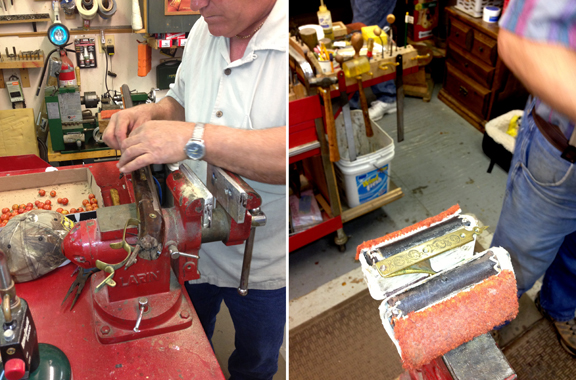
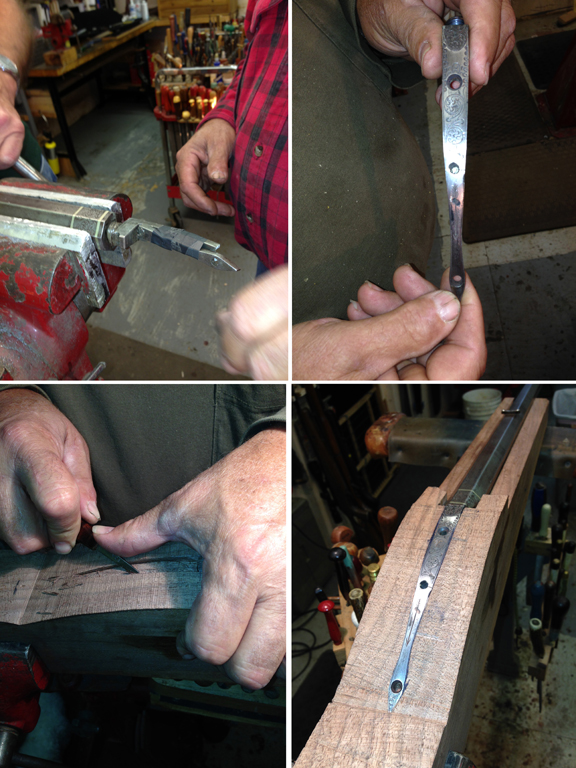
As can be seen in the photos Mike took while the work was in progress Sam did a superb job on the restoration. The lock was completely disassembled and cleaned, and the barrel de-breeched so the tang could be repaired. Originally there was an under-barrel rib, which in the rifle’s 140+ year history had somehow been lost, as had the ramrod. A new rib “distressed” to match the rest of the metal was fabricated: it is the only major part that had to be replaced. The pewter nose cap was re-cast to the shape of the original and the inlays carefully removed and preserved, later being inset into the new stock in exactly the same positions as in the old one. The breech plug tang was broken: Sam repaired it and inletted the stock blank to receive it. Examining the configuration of the muzzle, we suspected there had originally been a "false muzzle," a removable device to allow loading without damaging the barrel crown. That would indicate this rifle was intended for target work rather than hunting. This suspicion was confirmed later by a senior curator at the National Firearms Museum, but unfortunately the false muzzle was lost long ago.
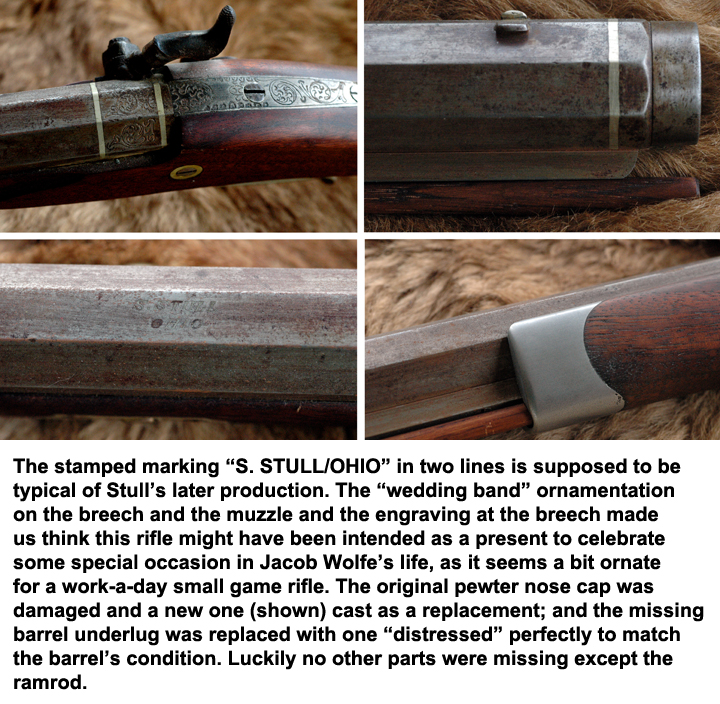
A year after the project was initiated, the Outdoorsman received the rifle from Sam at the entrance to the National Firearms Museum.

In its restored state, the Stull rifle briefly hung proudly over the fireplace of Jacob Wolfe’s granddaughter. Leo’s only male descendant didn’t want it, and on February 6, 2019, it was donated to the National Firearms Museum. We hope it will be put on display as an exceptionally nice example of the “Ohio Rifle” of the mid-19th Century.
ADDENDUM, April 15, 2019: The Stull Rifle Goes on Display
I had this note today from Mr Doug Wicklund at the National Firearms Museum:
[O]ur exhibit at the Chantilly Expocenter last weekend featured the Sam Still Ohio rifle and powderhorn that you donated recently. They were part of an exhibit called “Guns Through the Generations” that told the story of guns that were passed down in families. I’ve attached an image of the exhibit.
 |
Needless to say, I'm very pleased and hope it will be put on permanent display in the NFM in time. I think my late father-in-law and his father, not to mention Sam Stull, would be very pleased at this.
Reference:
Tilton, F.G. Ohio Gunsmith: Samuel Stull (1808-1907). Journal of the Association of Ohio Long Rifle Collectors, September 1981, pp. 2-4.
| HUNTING | GUNS | DOGS |
| FISHING & BOATING | TRIP REPORTS | MISCELLANEOUS ESSAYS |
| CONTRIBUTIONS FROM OTHER WRITERS|
| RECIPES |POLITICS |